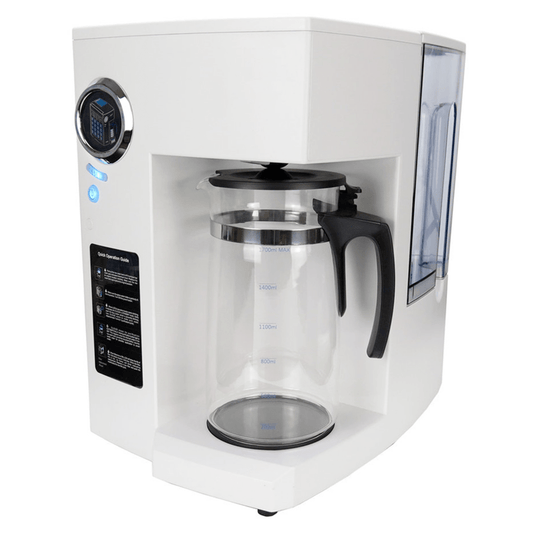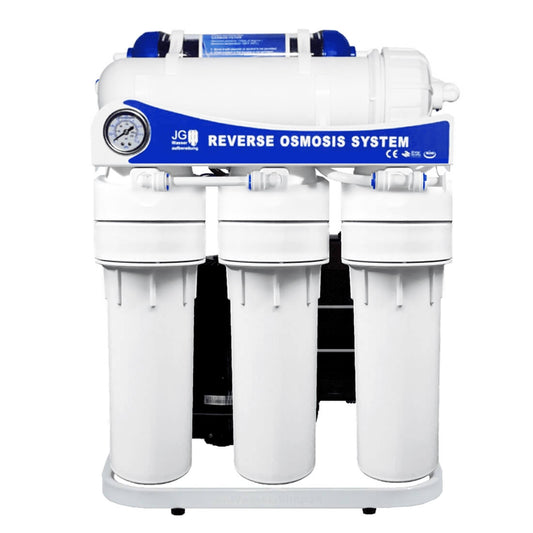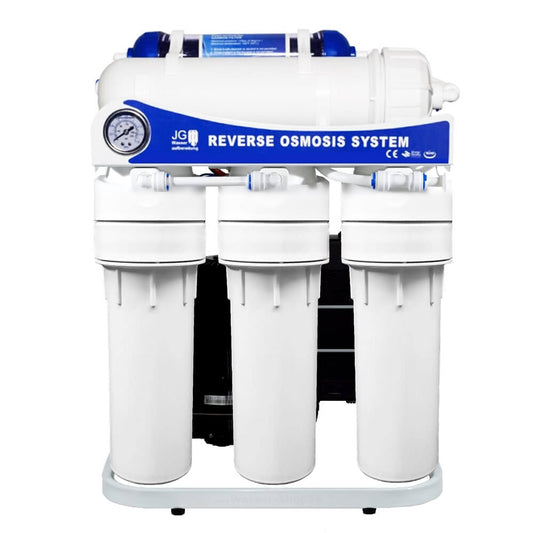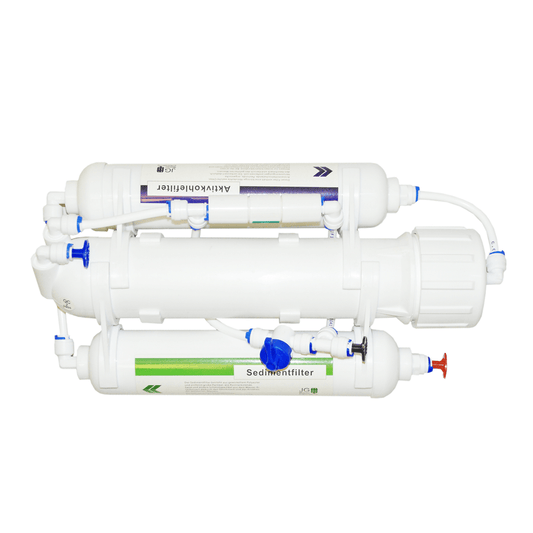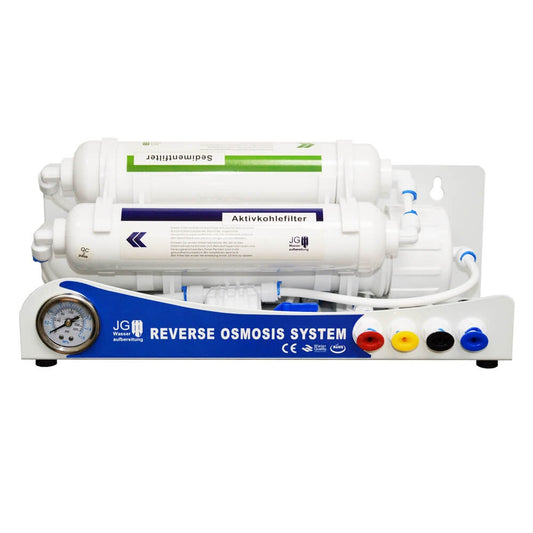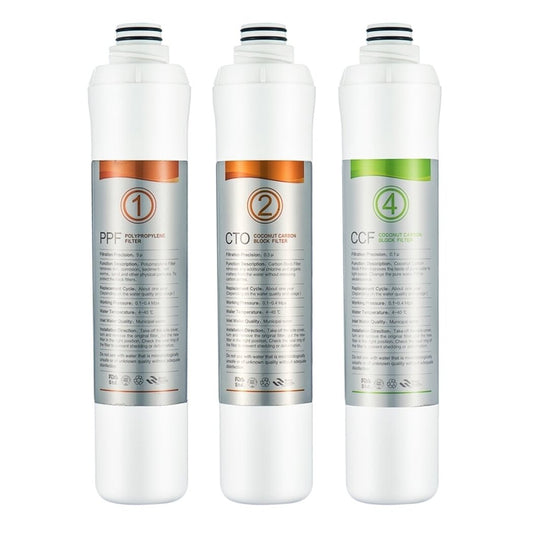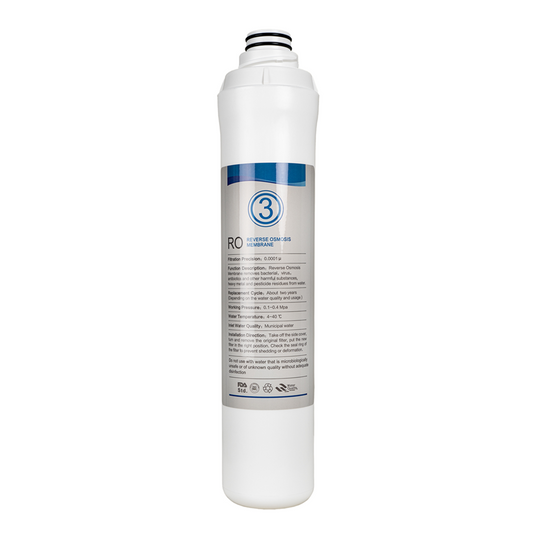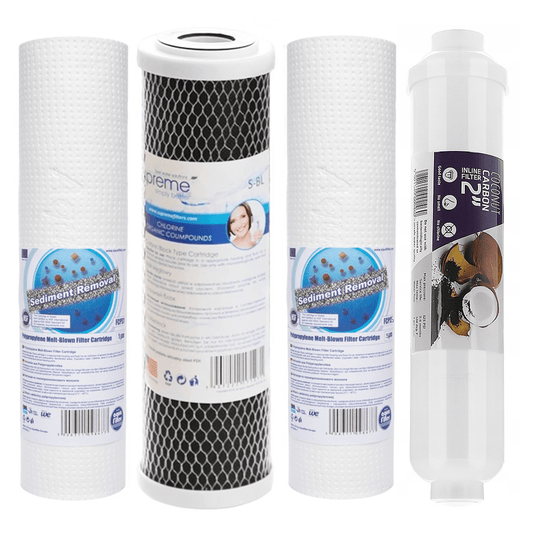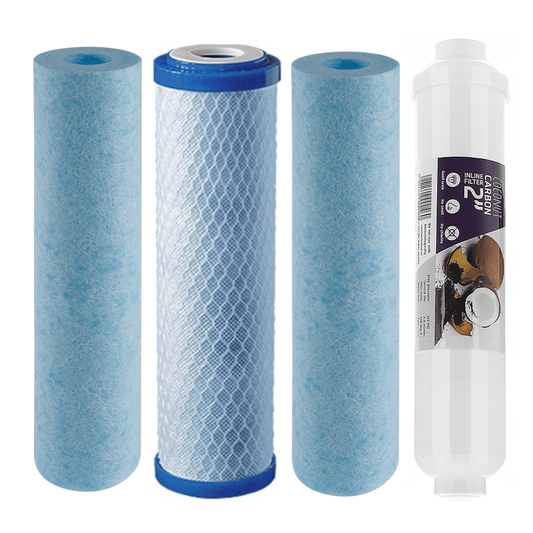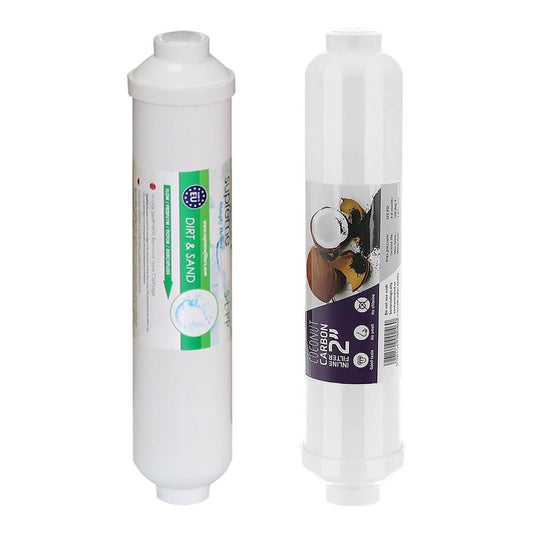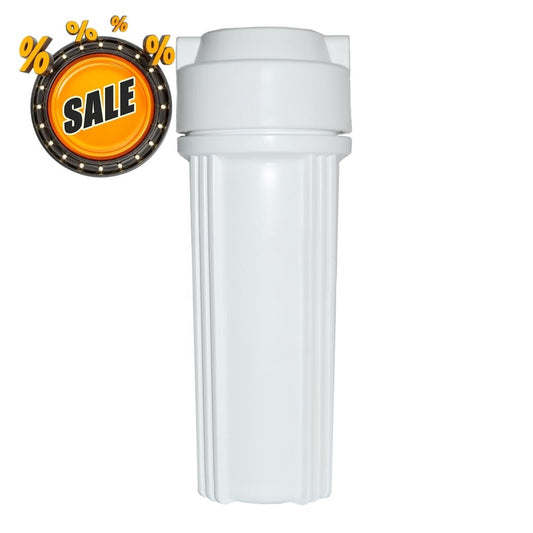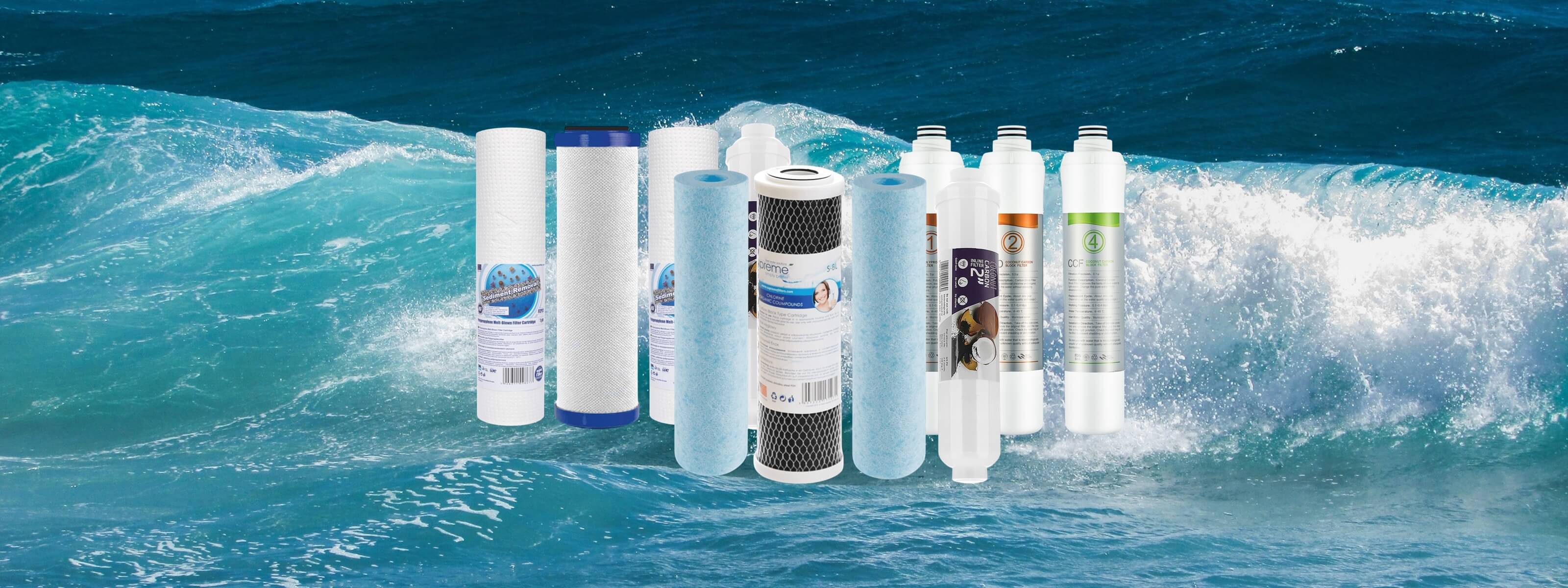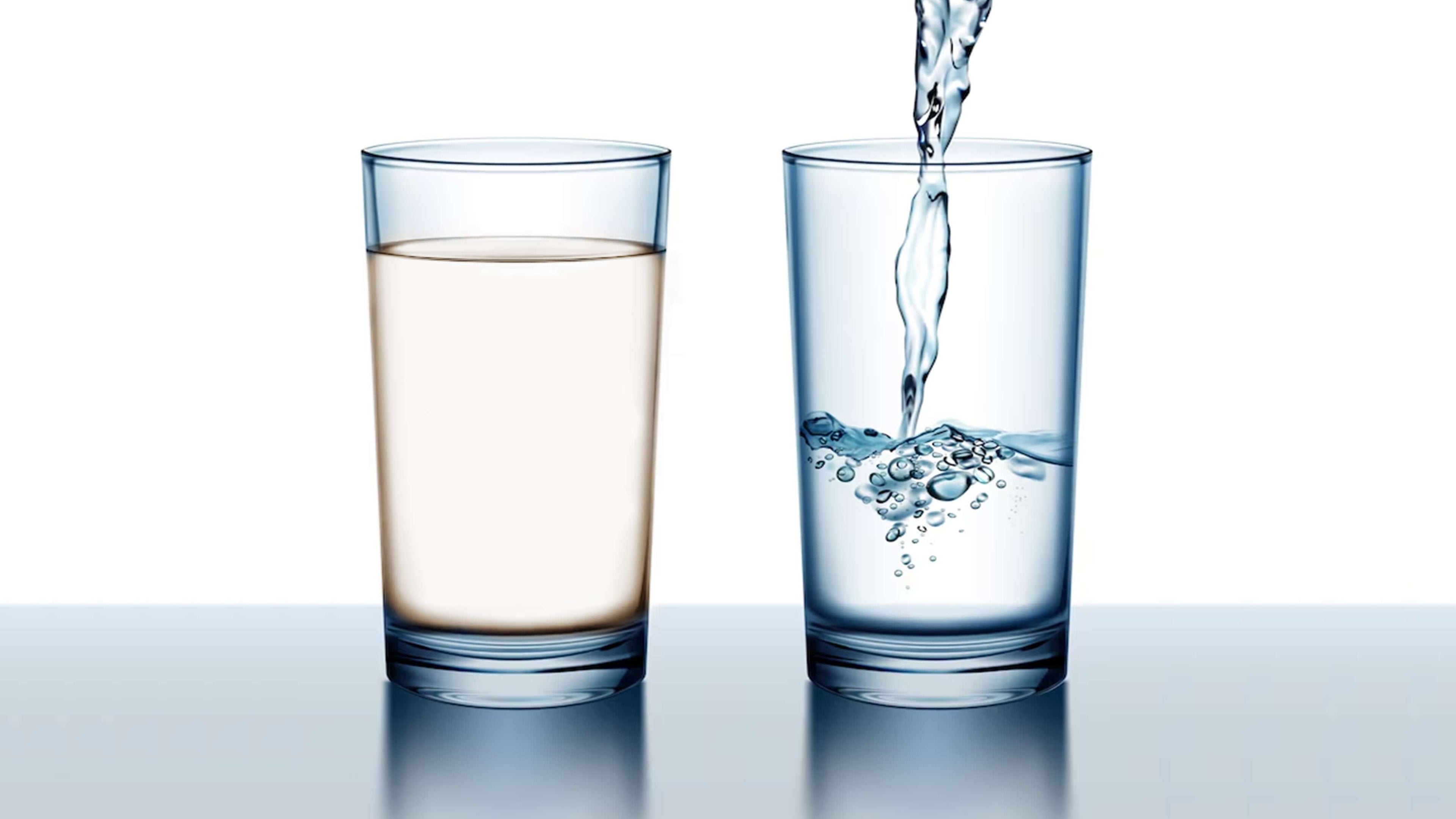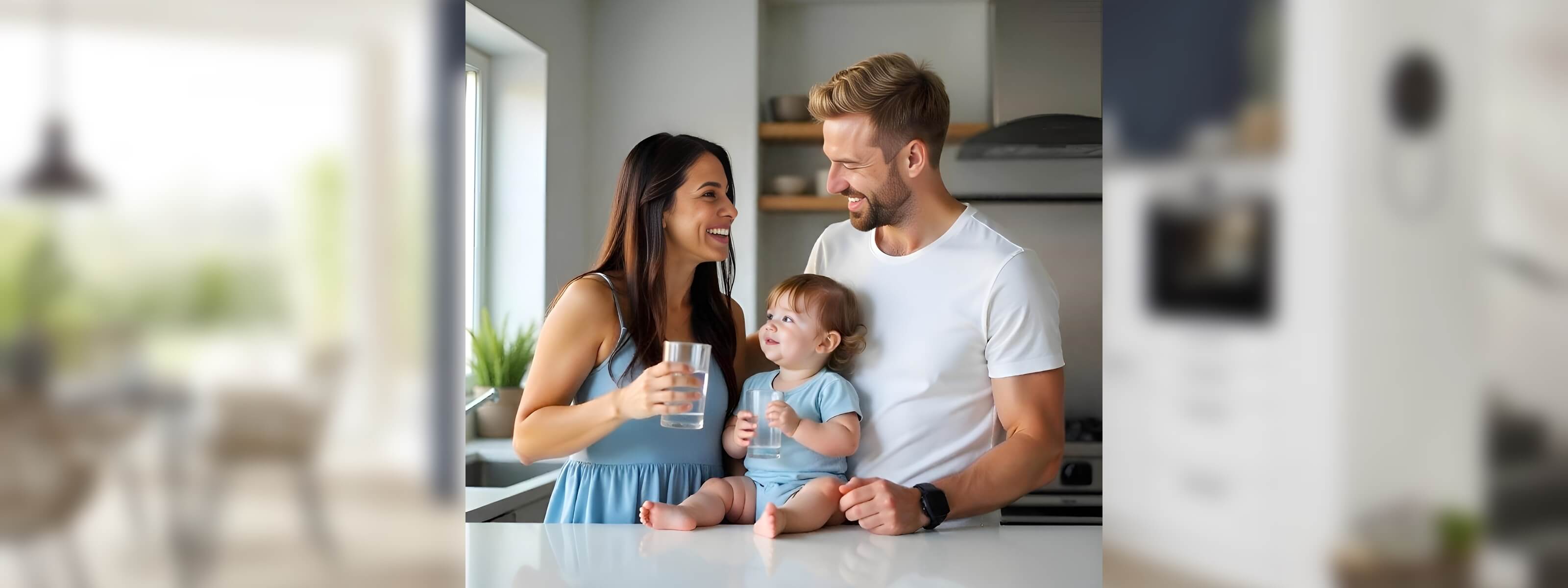-
Ropot-Elegance 3 reverse osmosis system 90 GPD white
Regular price 397,00€Regular priceUnit price per -
1000 GPD Compact TWO Flow
Regular price From 747,97€Regular priceUnit price per899,00€Sale price From 747,97€Sale -
800 GPD Professional Brushless 1:1 - 3213
Regular price From 587,00€Regular priceUnit price per639,00€Sale price From 587,00€Sale -
600 GPD Professional Brushless 1:1 - 3013
Regular price From 447,00€Regular priceUnit price per487,00€Sale price From 447,00€Sale -
Mobile reverse osmosis system
Regular price From 56,97€Regular priceUnit price per -
Small reverse osmosis system
Regular price From 75,97€Regular priceUnit price per
-
Quick Change filter set Ropot 3
Regular price 69,97€Regular priceUnit price per -
90 GPD membrane Ropot-Elegance 3
Regular price 69,97€Regular priceUnit price per -
Filter set Aquafilter Supreme Green Filter
Regular price 26,14€Regular priceUnit price per -
Filter set Sanic Aquaphor activated carbon block
Regular price 56,72€Regular priceUnit price per -
Supreme / Green Filter Inline filter set
Regular price 17,94€Regular priceUnit price per -
Filter housing series JG 10 inch
Regular price From 12,00€Regular priceUnit price €12,00 per item24,95€Sale price From 12,00€Sale
Discover your 🎁 FREE gift with every
Order 🛒 free ✅ order with us!
Info about Pure Water
Why pure water?
The importance of pure water
Pure water is essential for life on our planet. Everyone should have access to pure and healthy water!
Our drinking water is regulated at the state level to protect people's health. The Drinking Water Ordinance guarantees that tap water is free of pathogens and harmful substances. It should be free of suspended matter, odor, and coloration. It is the most strictly controlled food in Germany. In comparison, the regulations for mineral and table water are more relaxed, although we often pay extra for bottled water.
Challenges in the household
But the water that comes from our taps isn't always as pure as we think. On its way to our homes, it can absorb contaminants that simply boiling can't remove. There are up to 2,000 different possible contaminants that can find their way into our drinking water.
Tap water and its dangers
- Heavy metals such as lead, arsenic and uranium, some of which are radioactive
- Residues of medicines such as antibiotics and hormones that enter the water cycle via wastewater
- Pesticides, herbicides and nitrates from agricultural use, which can convert into harmful nitrite in the body
- Chlorine and chlorides, which are used for disinfection but can cause taste changes
To minimize these risks, installing a reverse osmosis system or a high-quality water filter is a good idea. These can help effectively remove unwanted substances and contaminants, giving you access to pure water.
our range
At Bayoo Trading UG - Water Shop24, you'll find solutions for pure water . Our product range includes over 500 items, including reverse osmosis systems and water filters that ensure the best drinking water. Benefit from our free shipping on orders over €50 and discover how easy it can be to supply your household with pure water.
Save me osmosis water
Save with osmosis water
Osmosis water is not only healthy, but enjoying pure water can also save you a lot of money. Families in particular benefit from this, because the more people live in a household, the more water is used daily. In addition to the diverse uses of osmosis water, significant amounts of money can be saved in the long run. Who wouldn't want that? Purchasing a reverse osmosis system pays for itself in just a short time. For your convenience, we've created a table overview. This compares inexpensive bottled mineral water from a discount store with pure osmosis water produced with a reverse osmosis system with a water ratio of up to 1:1, at a total water price of €5.00 per m³ of tap water.
How much does water cost over time?
Osmosis water - unbeatable in price and quality
The overview shows that you can save a lot of money with osmosis water, even if the purchase of a reverse osmosis system seems a bit expensive at first. However, after a short time, you'll be saving money day after day, month after month, and year after year. Don't pay so much for bottled water, which is a burden on your health and your finances!
Save a lot of money in the long run with your own reverse osmosis system and enjoy the unbeatable quality of pure osmosis water, right at home! No lugging around crates. No deposit required. No store-bought water can compete with pure osmosis water in price and quality! Get your own fresh spring water directly at home.
Osmosis water application
Make your own osmosis water - clear, soft and healthy
The term "osmosis water" has been known in the aquarium hobby for a long time. This type of water, produced in its purest form, is very popular for keeping fish healthy. For decades, more and more people have preferred the particularly pure osmosis water for drinking water for health reasons. You can produce this particularly pure osmosis water yourself at home using a reverse osmosis system from your tap water. There are no limits to the applications of osmosis water. Wherever pure water is needed, you can use osmosis water with the best results.
Application of osmosis water
You can use osmosis water for drinks, cooking, preparing baby food, making coffee and tea, for fully automatic coffee machines, for facial and skin care, for shaving, as drinking water for your pets, for watering plants, for making ice cubes, for using steam cleaners, for humidifiers and for your aquarium, for film development, for your car's wiper and washing system and much more.
Osmosis water has many possible uses in the home or for your hobby. Furthermore, this pure water is free of limescale and protects all your household appliances from unsightly limescale and dirt. You will get more enjoyment from your appliances, such as your steam iron, kettle, coffee maker, indoor fountain, etc. Also worth noting is the cleaning power of pure water for surfaces, such as windshields, ceramic hobs, mirrors, window panes, the display of your smartphone, and so on. This also extends the lifespan and maintenance intervals of your appliances. In the future, you can easily and conveniently draw your own pure water directly from your own reverse osmosis system at home and enjoy the many benefits of fresh, pure osmosis water. We would be happy to advise you and look forward to hearing from you.
Healthy pure water
Once you and your family discover the fresh, thirst-quenching taste of pure water, you'll see this essential ingredient in a whole new light. With pure drinking water from a reverse osmosis system, you're consuming exceptionally pure and healthy water—water in a pure, uncontaminated form, free from any contaminants.
Soft, lime-free water for coffee, tea, fruit spritzers & other drinks
"Just add water," is the motto in many preparations. By using pure water, you're adding water without any unpleasant taste or impurities. Coffee and tea, in particular, taste better than ever with reverse osmosis water. Why? You only taste the coffee or tea, not the salts and metallic compounds that come with tap water, which, for example, make coffee bitter and sour. In addition, coffee or tea can develop its full aroma better. Have you heard that?
Fresh, 100% fruit juices with no added sugar are healthy and rich in vitamins. However, these 100% fruit juices often still contain a lot of fructose and, consequently, a lot of calories. To reduce calorie intake, you can easily make a healthy, light fruit juice spritzer using reverse osmosis water. Simply mix your 100% fruit juice with the reverse osmosis water. At the same time, any fruit acid present is also reduced. This makes a fruit juice spritzer more pleasant to drink and easier to digest. Foodies will quickly notice the difference.
Preparing baby food
"Just add water," is the message in many baby formula or baby food packages. Pure osmosis water is ideal for the healthy preparation of baby food and is particularly suitable because it is free of nitrates, heavy metals such as lead, copper, etc., drug residues, pesticides, and many other contaminants, and also contributes to a low-sodium diet for babies. Give your baby uncontaminated water from the very beginning, whether as tea, to dilute fruit juices, or as pure water to drink. Safe and healthy from the start.
Cooking and preparing food
Pure water has a wide range of uses, including preparing food and beverages for a pure taste (soups, sauces, vegetables, tea, coffee, etc.). Ordinary tap water with chemical additives such as chlorine, salts, and inorganic contaminants impairs the taste of vegetables, soups, sauces, and all foods cooked in water. From now on, cook only with pure water and taste the difference. When you cook with pure water, you'll also be pleased to see that your pots, coffee maker, and kettle no longer develop limescale.
Clear ice cubes with osmosis water
Make your ice cubes only with reverse osmosis water. You'll be amazed at how clear your ice cubes are—no more white inclusions, and the taste of your drinks will always be consistent.
Support for a diet with pure osmosis water
Many mineral salts in tap and mineral water bind water in the body. The more salt you consume, the more excess weight you carry around. Osmosis water supports any diet by eliminating these unnecessary ingredients. If you've previously made your drinks with tap or mineral water, you should try the following: Drink two to three liters of osmosis water for a month without changing your diet. See if you can celebrate losing a few pounds. No other water has this effect!
Pure water for facial & skin care
Your skin will also thank you for your osmosis water care. The clean water deeply cleanses the skin and gives it a radiant, fresh appearance with a firm surface. Water replenishes the skin's layers and makes you look years younger.
Delicious soft water ideal for your pets and aquariums
Animals instinctively know which water is good for them. Try it out: Set up two bowls, one with tap water and one with reverse osmosis water. You'll see, your pet will choose reverse osmosis water. This pure water is also very tasty and odorless for animals. Animals are true gourmets and incorruptible.
Pure water is ideal for aquariums . Reverse osmosis and water filters are used in aquariums. They are used for aquarium inhabitants and plants with particular demands for the high quality of pure, uncontaminated water. Your fish in the aquarium thrive in a mixture of osmosis water and tap water. This mixing is also called blending. Pure water makes aquarium water softer because it is free of limescale and also free of contaminants. Take a look at your bottle of aquarium water optimizer; then you'll know what contaminants can be found in tap water! After all, the water optimizer must neutralize precisely these contaminants in tap water before the water can be called aquarium water.
Water your plants with pure water for better growth
Osmosis water is an ideal solvent for plants to draw nutrients from the soil. Water your plants with osmosis water and watch them grow and thrive. You'll be amazed. Everyone will envy your magnificent plants.
Demineralized water for humidifiers - limescale-free
Humidifiers and air purifiers release water into the air. Almost all devices quickly develop unsightly deposits, such as limescale or rust. This encrustes the mechanism and ultimately destroys it. With demineralized water, you won't have this problem. Your devices, such as humidifiers, indoor fountains, water-cooled air conditioners, etc., will remain limescale-free and thus stay like new for longer.
Lime-free water for windscreen washer & car care
What driver would ever think of filling their windshield washer system with purified water from an osmosis system? But try it, and you'll never use any other type of water for your windshield washer system again. With osmosis water, you won't have streaks on your windshield, and the spray water that runs off won't leave marks on the glass or paint. Even modern car washes use osmosis water for cleaning. Wash your car with osmosis water. Osmosis water won't leave streaks or even limescale stains on your car. The car paint, as well as the windshield and rear window, will be free of limescale deposits. The car paint will shine, and the clean windows will ensure a clear view.
Membrane technology
Membrane technology
How does reverse osmosis work
Reverse osmosis is a water filtration process based on the principle of osmosis. Here are the basic steps of how reverse osmosis works:
Osmosis: First, it's important to understand what osmosis is. In osmosis, water molecules move through a semipermeable membrane from a solution with a lower concentration of solutes (e.g., salts) to a solution with a higher concentration to reach equilibrium.
Reverse osmosis: In reverse osmosis, this natural process is reversed. By applying pressure to the concentrated solution (e.g., tap water), the water is forced through the semipermeable membrane. This membrane allows only water molecules to pass through, trapping larger molecules, ions, and contaminants (such as heavy metals, salts, bacteria, and other pollutants).
Filtration: The water that passes through the membrane is called "purified water" or "permeate." The water that does not pass through the membrane is called "concentrate" or "effluent" and contains the trapped contaminants.
Post-treatment: After reverse osmosis, the purified water is often passed through additional filters (e.g. activated carbon filters) to improve taste and odor.
Storage: The filtered water is stored in a water tank from where it can be drawn when needed.
Reverse osmosis is an effective method for producing pure water free from many contaminants and is widely used in households, industry, and aquariums. If you have any further questions or would like more details, I'm happy to help!
The principle of reverse osmosis has been the best and most cost-effective method for producing pure and healthy osmosis water for over 60 years. For decades, the principle of reverse osmosis has been successfully used wherever pure water is needed, such as in medicine, pharmaceuticals, the food industry, on ships and in space travel, etc. Below, we explain the function of the reverse osmosis membrane.
Water treatment, pre-filtration in osmosis systems
The tap water (raw water) is treated in the pre-filter system. The 5µm sediment filter (1st stage) removes coarse particles such as sand, rust, limescale, suspended matter, etc. The 5µm activated carbon block filter (2nd stage) removes chlorine and organic contaminants. It also filters out suspended and flavored substances and organic contaminants dissolved in the water. The 1µm sediment filter (3rd stage) removes particularly fine particles and suspended matter and protects the membrane from any activated carbon dust that may be present. Depending on the system and requirements, other pre-filters can also be combined and used.
Reverse osmosis membrane technology
Filtration in the pre-filter system increases the purification level in the subsequent membrane filtration technology (4th stage) and extends the lifespan of the membrane. The tap water (raw water) is pressed against a synthetic, semi-permeable membrane with a pore size of only 0.0001 µm, which is permeable only to water molecules and not to impurities in the tap water (raw water). Therefore, only clean, pure water collects on the other side of the membrane. The impurities are flushed away and drained directly into the drain. The pressure of the tap water is sufficient to force the water through the membrane. The membrane is the heart of a reverse osmosis system. This removes almost all harmful substances and flavors, such as bacteria, viruses, germs, hormones, antibiotics, drug residues, pesticides, herbicides, fungicides, lead, arsenic, sulfur, lime, radioactive substances, nitrate and almost all other harmful substances.
The retention rates of various substances in a TFC membrane (plastic) made of polyamide-polysulfone (measured by electrical conductivity)
All molecules larger than the 0.0001µm water molecule are retained by the reverse osmosis membrane. The larger the molecule, the better it can be removed from the water. Heavy metals, for example, have a very high retention rate due to their size. Complex molecular structures such as hormones, viruses, drug residues, etc., are almost completely removed from the water. X-ray contrast media, if used in the form of an aqueous suspension of barium sulfate (BaSO4) (water-insoluble), or as iodine in the form of a triiodinated benzene ring (water-soluble, ionic/non-ionic), or in an oily (water-insoluble) compound, are also almost completely removed from the water.
Post-filtering
All of our reverse osmosis systems are equipped with an activated carbon post-filter or (activated carbon post-filter & combination filter), which filters the purified water again before use and ensures a pleasant and neutral taste.
Mineralization / Vitalization
Optionally, any reverse osmosis system can be upgraded with a mineral filter, energizing filter, or vitalizing filter. Depending on the selection, these contain one or more filter media with different compositions. These create agitation in the water. Depending on the type of filter, the water is mineralized, energized, or vitalized. Trace minerals are added, significantly improving the water density, ionization, conductivity, surface tension, and, above all, the pH value. The water acquires a natural and invigorating taste.
Dependencies for osmosis water performance
The maximum performance of a reverse osmosis membrane is specified at approximately 20°C. At lower water temperatures, the purified water (osmosis water) performance decreases. This occurs, for example, in the winter months. For every 1°C lower than 20°C, the purified water performance decreases by 4%. The membrane fabric contracts at low temperatures, allowing less purified water (osmosis water) to pass through. This can increase the amount of wastewater. The purified water quality is improved at lower water temperatures.
Test your water with a TDS meter
We recommend our TDS meter. This device allows you to measure conductivity. It measures the total dissolved solids (mobile ions, including minerals, salts, and metals) in a specific volume of water, expressed in mg per volume of water (mg/L), also known as particles per million (ppm). Filtered water has an optimal concentration of approximately 10-20 ppm. If the concentration exceeds 60 ppm, the filters should be replaced. For comparison, normal tap water has a conductivity of approximately 200-500 ppm and higher.
Taste of osmosis water
What does pure water – osmosis water – taste like?
Osmosis water itself has a naturally neutral taste . However, this taste can be perceived differently. Therefore, the same glass of osmosis water can taste sweet to one person, sour to another, and bitter or metallic to yet another, as the filtered and neutral osmosis water is an excellent flavor carrier. This different perception of taste does not indicate a defect in the osmosis system; rather, when you taste this osmosis water, you are primarily tasting yourself.
Within a household with different people, you can see that the taste of osmosis water is perceived differently, so you can see that it is not the osmosis water that contains the taste, but that the differences lie between the different people.
Taste perceptions can vary
If the osmosis water is perceived as sweet or neutral, that's normal. If the osmosis water is perceived as acidic, then your body may be over-acidified. If the osmosis water is perceived as bitter, this could be an indication of problems with the digestive tract, liver, or gallbladder. If the osmosis water has a metallic taste, this could indicate elevated levels of heavy metals, for example.
In this case, osmosis water acts like an indicator and can point to existing problems in the body. This property of osmosis water is to be viewed as positive, as it provides an indication for significant improvement in specific areas of the body through targeted measures.
Most people who drink osmosis water find that after a few weeks, the initial taste perceptions diminish or disappear completely. In this case, after an adjustment period, the body registers that toxins and harmful substances can now be released from the body into the water, as the osmosis water serves as a transport medium and can absorb more pollutants than regular tap or bottled water.
Experience shows that after several weeks or months, the body has released most of the unwanted stored toxins from the body and thus the unusual taste sensation diminishes and disappears completely. This means that osmosis water also undergoes a kind of purification and detoxification treatment.
Maintenance-Filter change
Filter change of pre-filter, activated carbon post-filter and mineral filter
To ensure consistently high water quality in your reverse osmosis system and water filter, the pre-filters and post-filters should be replaced regularly.
The recommended replacement interval for the pre-filter and post-filter in reverse osmosis systems and water filters is approximately every 6 months² for medium water quality (depending on the degree of contamination, pollutant load, and water hardness), or when the pure water value exceeds 60 ppm (93 µS). Whichever occurs first is relevant. This recommendation assumes normal household use , not industrial use , and not use with extremely high water consumption , e.g., for large aquariums.
- Recommended filter change: every 6 months² with normal household use and an average tap water of approx. 250 ppm .
- If you have a high water consumption, e.g. for water changes in a large aquarium, it is necessary to change the filters earlier and more often.
- In case of high usage (e.g. aquariums) or poor water quality on site, a filter change is recommended: every 3-4 months².
²The filter replacement interval depends on the water quality of the raw water. This factor influences the lifespan of the filters and the membrane. Therefore, recommendations are based on average drinking water quality in Germany.
Water hardness for reverse osmosis systems and water filters
The higher the dH value, the harder the water. There are uniform regulations in Germany regarding when water is considered soft or hard. Up to a measured value of:
- 8.4 °dH the water is considered soft
- from 8.4 °dH to 14 °dH as medium and
- from 15 °dH accordingly as hard
For reverse osmosis systems, raw water of medium hardness °dH is recommended.
Recommended filter change
- You can find new replacement filters in a set here.
- Of course, you can also purchase each filter individually from us.
- You can purchase Atlas Filtri replacement water filters here.
- You can also purchase mineral filters from us.
Disinfection of reverse osmosis systems and water filters
We recommend performing a thorough disinfection of the reverse osmosis system or water filter every time you change the filter. With knick'n'clean aqua, we offer a highly effective disinfectant for water filters, reverse osmosis systems in the home, boats, and caravans. knick'n'clean® aqua can also be used to directly disinfect up to 500 liters of drinking water.
Recommended membrane change
The reverse osmosis membrane is the heart of the reverse osmosis system, where the actual water separation process takes place. Our systems use only high-quality, long-lasting TFC membranes. The membranes should also be replaced regularly. The replacement time depends on the water quality and the flow rate already achieved.
- 50 GPD membrane: approximately every 12 months² (GALANT, Elegance 1, Elegance 2, Quella Nova or similar systems)
- 50 GPD - 75 GPD membrane: approx. every 12-24 months²
- 85 GPD membrane: approximately every 12-24 months (ROPOT, Elegance 3, Quella Viva or similar systems)
- 125 GPD - 200 GPD membrane: approx. every 12-24 months²
- 300 GPD - 400 GPD - 500 GPD - 600 GPD - 800 GPD Membrane: approx. every 36-60 months²
²Depending on flow rate and local water quality.
Depending on the model, a reverse osmosis system is equipped with a manual flush valve (optional). This flush valve allows you to flush the membrane and thus extend its service life. We recommend opening the manual flush valve every 14 days for approximately 10-15 minutes to flush the membrane. If your reverse osmosis system does not have a flush function, a manual flush valve can be retrofitted.
Maintenance of reverse osmosis systems
Wear parts such as the booster pump, power supply, solenoid valve, autoflush and flow valve have a limited service life and must be replaced or cleaned regularly.
Longlife Booster Pump - Service life of up to 10 years with normal household use and compliance with interval use of max. 60 minutes.
- Brushless booster pump - Service life: up to 2000 operating hours when used at intervals of max. 12 hours.
- Standard booster pump - service life: up to 2000 operating hours when used at intervals of max. 30 minutes.
- Ronda Booster Pump - Service life: up to 3000 operating hours when used at intervals of max. 12 hours.
- Passive booster pump - Service life: up to 1000 operating hours when maintaining a maximum water inlet pressure of 3 bar. The pressure can be adjusted using the system's pressure reducer at the water inlet.
- FLOW valve ( flow restrictor ) - If the clean water output decreases, descale the flow valve or replace it. Regular descaling is recommended (e.g., with lemon juice) to ensure proper wastewater flow. A reverse osmosis membrane must produce a certain amount of wastewater to flush the deposited contaminants from the membrane. This is the only way to avoid unnecessary stress on the membrane and thus maintain its long service life.
TDS meter or MicroSiemens meter
Testing your drinking water with a TDS meter is the best and easiest way to determine when a filter change is necessary. TDS meters are also available at our Water Shop24. If the value exceeds 60 ppm, the filters should be replaced. TDS meters, conductivity meters , and pH meters are also available at our Water Shop24.
How many centimeters are in an inch?
2.54 cm = 1" (written as " = inch)
What does GPD mean?
The designation GPD on the membrane indicates the pure water output per day. GPD stands for gallons per day and is an American unit for liquids. The water output/water quantity of a reverse osmosis membrane is generally specified in GPD. For clarity, this is converted from GPD to liters per day. For every reverse osmosis membrane and every reverse osmosis system, the water output is specified in GPD and liters for the daily output. In addition, a further conversion from GPD to liters per minute is performed. This quickly shows how quickly the osmosis water is produced and gives you a precise idea of how quickly it is produced. This allows you to determine and select the optimal reverse osmosis system based on your water requirements.
How many liters are in 1 gallon?
The conversion from gallon to liter is: 1 gallon = 3.7854100 liters
Determine the performance of a reverse osmosis system
The pure water flow is generally determined without the rinsing phase. You will need a 1-liter measuring cup and a stopwatch for this.
Proceed as follows:
- Open the osmosis faucet.
- Typically, an osmosis system begins with an automatic flush (integrated autoflush). This is a flushing phase lasting approximately 18 seconds during which the water flow is reduced.
- It is essential that you wait until this rinsing phase has completed before you carry out the time measurement for the volume quantity determination.
- The flushing phase is recognizable by the fact that during this time (approximately 18 seconds) only a small amount of water (stale water from the system) flows from the reverse osmosis faucet. The larger amount of water flows away through the drain hose during this time, since the flushing function is activated at the same time.
- The actual osmosis water production can be recognized by the increasing, stronger water jet after these first 18 seconds, and at the same time the pump can be heard more loudly.
- To ensure the rinsing phase is complete, start the timer when you turn on the faucet. After 18 seconds, stop the timer, let the water continue running, reset your stopwatch, and then start filling the 1-liter measuring cup, simultaneously restarting the stopwatch.
- When timing, stop the water supply after 30 seconds, as the osmosis system's output is given in liters per minute.
- Double the amount in the measuring cup and you will get your system's performance value.
Note: The performance and quality of the pure water produced by a reverse osmosis system depends on the water quality of the tap water, such as temperature (at 20°C), conductivity, hardness, and pH. With an average tap water concentration of approximately 250 ppm, pure water with a conductivity of approximately 5-25 ppm (8-40 µS) is possible (without mineralization). The cooler the tap water, the better the pure water quality can be achieved. However, the performance decreases by approximately 4% for every 1°C lower water temperature – and vice versa.
Quality with certificate
Reverse osmosis systems for home use - quality at fair prices
Our online shop, "Wasser-Shop24," has been operating since 2008. Identical or similar reverse osmosis systems are often offered for direct sale on the market, sometimes for over €3,500. These offers involve a multi-level trading system in which more than five intermediaries and/or salespeople, or commission earners, may participate in the sales price. However, this sales system also requires enormous effort, including personal consultation and on-site support.
Unfortunately, we cannot offer this service due to our low online pricing. We are happy to advise you by phone and email, and you can also find a lot of information on our website at Wasser-Shop24. Decide for yourself whether you want to spend up to 10 times the price for personal advice and on-site contact. We offer our reverse osmosis systems, spare parts, filters, and accessories at fair prices that EVERYONE can afford.
WQA is the abbreviation for Water Quality Association . It is a non-profit association that sets the highest quality standards for the water filtration industry. The association maintains intensive dialogue not only with other organizations, but also with the industry, governments, and, of course, with end users. The Water Quality Association is a resource and information source, a voice for the industry, a guide for professionals, a laboratory for product testing, and thus a competent partner for the water filtration industry.
NSF is the abbreviation for National Sanitation Foundation. It is a non-profit, independent organization specializing in technical standards and educational activities in the fields of public health and environmental protection. NSF tests products for safety defects and health hazards and, if they pass, awards the NSF certificate. The standards NSF places on products are significantly higher than those required by German or EU law, for example.
The GS mark stands for tested safety and is a recognized safety mark recognized far beyond Germany's borders. In the area of consumer protection, it guarantees that the safety requirements are met and are tested and regularly monitored by an independent body.
The CE mark guarantees that a product complies with the requirements of the relevant EC directives. The CE mark makes it clear to all consumers in Europe that this product meets European standards in terms of safety and health.
Why osmosis systems should not be missing in any household
Water plays a central role in our everyday lives – whether for cooking, drinking, or for our health. But even though our tap water is regularly tested, it's not always as pure as many people think. Residues of medications, hormones, nitrate, chlorine, and limescale are not uncommon. This is precisely where reverse osmosis systems come into play.
At Wasser-Shop24, we've made it our mission to offer you the best solutions for healthy and clean drinking water. Reverse osmosis systems are among the most effective methods of water filtration and are a true investment in your health. In this article, you'll learn everything about how reverse osmosis systems work, their advantages, and possible uses—and why a visit to our shop is definitely worth it.
Contaminated water vs. clear, pure osmosis water
What exactly are osmosis systems?
The technology behind reverse osmosis
Osmosis systems work on the principle of reverse osmosis. Tap water is forced through a semipermeable membrane that traps almost all dissolved substances—including heavy metals, nitrate, pesticides, drug residues, and even microplastics. Only pure water (H₂O) passes through the membrane and remains.
Typical structure of an osmosis system
1. Pre-filter
Removes coarse particles such as rust, sand and suspended matter.
2. Activated carbon filter
Binds chlorine, odors, organic contaminants and improves taste.
3. Pre-filter
Removes fine particles such as carbon dust from the activated carbon filter and protects the reverse osmosis membrane.
4. Reverse osmosis membrane
Removes up to 99% of all contaminants - including heavy metals, nitrate, fluoride, drug residues and more.
5. Post-filter
(e.g. coconut activated carbon): Optimizes taste and water structure.
6. Remineralization (optional)
Restores healthy minerals.
This multi-stage filtration ensures that the water from your osmosis system tastes particularly pure and pleasant.
The biggest advantages of osmosis systems
1. Pure drinking water for the whole family
With an osmosis system, you get water that is free of pollutants, bacteria, and residues – ideal for children, seniors, pregnant women, and pets.
2. Better taste for more drinking pleasure
Many of our customers report that reverse osmosis systems have finally made them enjoy drinking water again. The neutral, smooth taste makes drinking water enjoyable again.
3. Less limescale in appliances and household appliances
Limescale is a common cause of broken kettles, coffee machines, and steam irons. Osmosis water protects your appliances and extends their lifespan.
4. No more lugging water crates
With an osmosis system, you have fresh water straight from the tap – without lugging, without plastic waste, and without the ongoing costs of bottled water.
5. Sustainable and environmentally friendly
Reverse osmosis water reduces your plastic consumption and protects the environment. Once you switch to a reverse osmosis system, you'll never want to go back.
Frequently asked questions about osmosis systems – answered clearly
Is an osmosis system really necessary?
Yes—especially if you want to ensure your water is free of contaminants, drug residues, or microplastics. Reverse osmosis removes up to 99% of all contaminants.
Are important minerals also removed?
Yes – but that's not a disadvantage. Most minerals in tap water are inorganic and difficult for the body to absorb. Our optional remineralization filters (mineral filters) add natural minerals such as magnesium or calcium upon request.
How often do filters need to be changed?
- Pre-filter: Every 6 months
- Membrane: Every 2–3 years (depending on filter performance and local water load)
- Post-filter: Every 6 months
In our shop you will find suitable replacement filters – with long-term availability and simple instructions.
Who are osmosis systems particularly suitable for?
- Health-conscious people : For pure water without compromise
- Families : Safe, e.g. nitrate-free water for baby bottles and toddlers
- Athletes & fitness enthusiasts : From amateur athletes to professional athletes - training with a healthy lifestyle
- Aquaristics fans : Optimal water for tropical fish
- Coffee & tea lovers : Full aroma without limescale and chlorine
- Plant lovers : Healthy plants thanks to lime-free water
- Pet owners : For small and large pets (hamsters, cats, dogs, horses, etc.)
- Allergy sufferers : Water without allergens, germs or other pollutants
Osmosis systems vs. other filter systems
-
Filter system: activated carbon filter
Filter performance: Medium
Maintenance: High
Running costs: Medium
Sustainability: Medium
-
Filter system: table water filter
Filter performance: Low
Maintenance: Very high
Running costs: High
Sustainability: Low
-
Filter system: osmosis systems
Filter performance: Very high (up to 99%)
Maintenance: Medium
Running costs: Low
Sustainability: High
The table clearly shows that osmosis systems are the most efficient and sustainable solution.
Customer favorites - reverse osmosis systems for every need
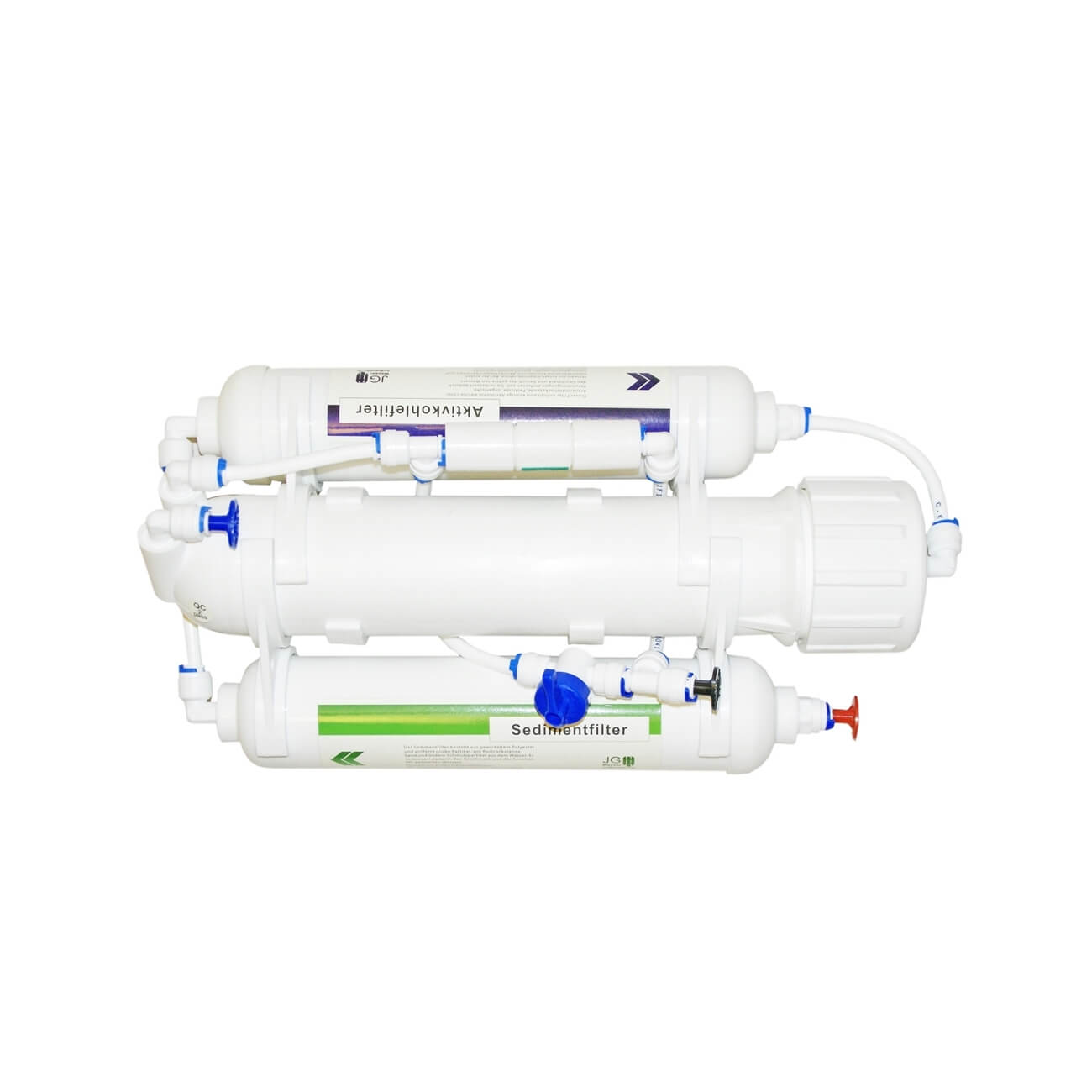
Mobile reverse osmosis system
Beginner-friendly: Mobile
- 3-stage filtration (50 - 200 GPD)
- Ideal for small households & when traveling, vacation, camping, hotel
- Compact & space-saving
- Can be connected to a regular tap
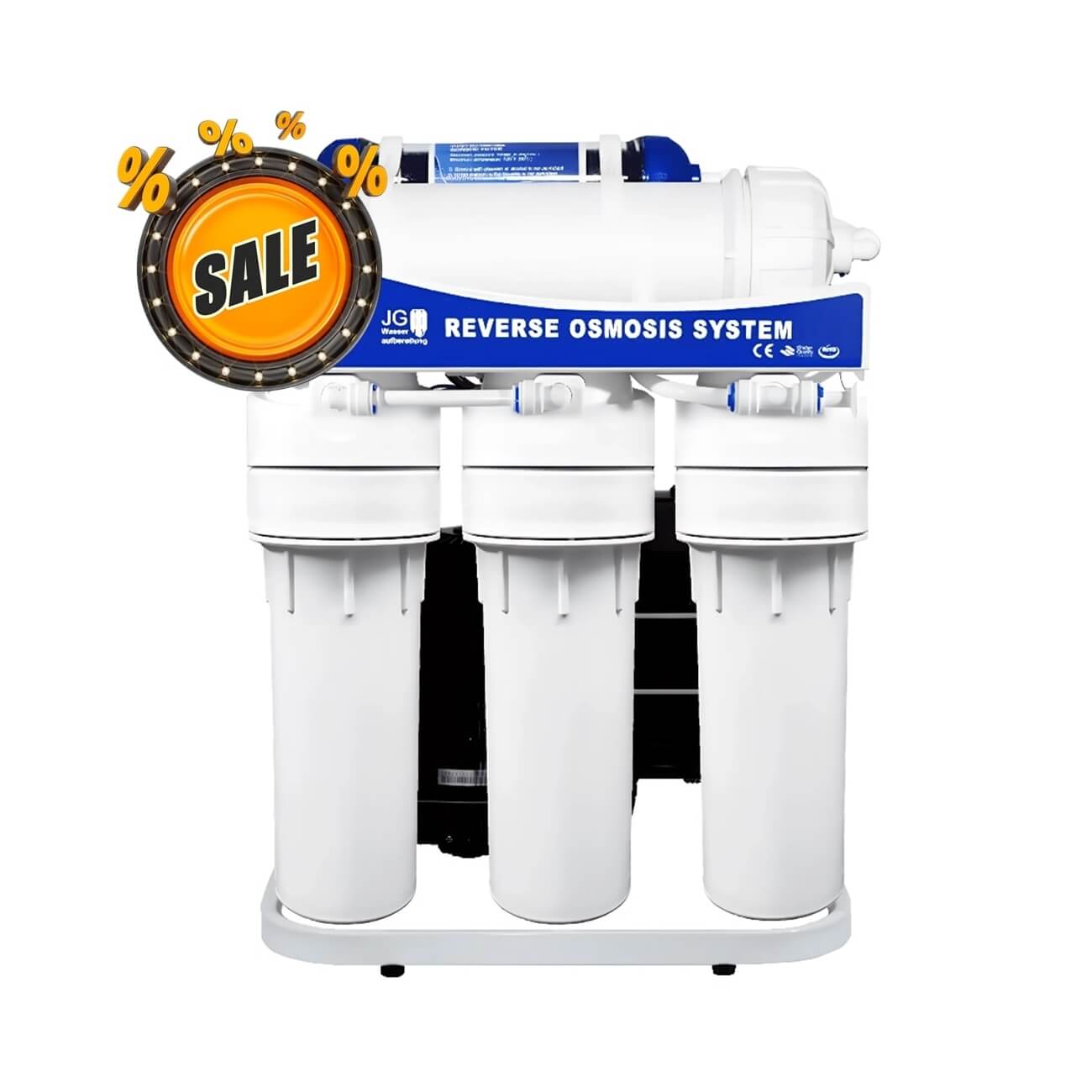
600 GPD Professional Brushless Reverse Osmosis System
Bestseller: 600 GPD Professional
- Direct system without tank
- High-flow membrane for fast water
- Water ratio 1:1
- Remineralization (optional) can be retrofitted
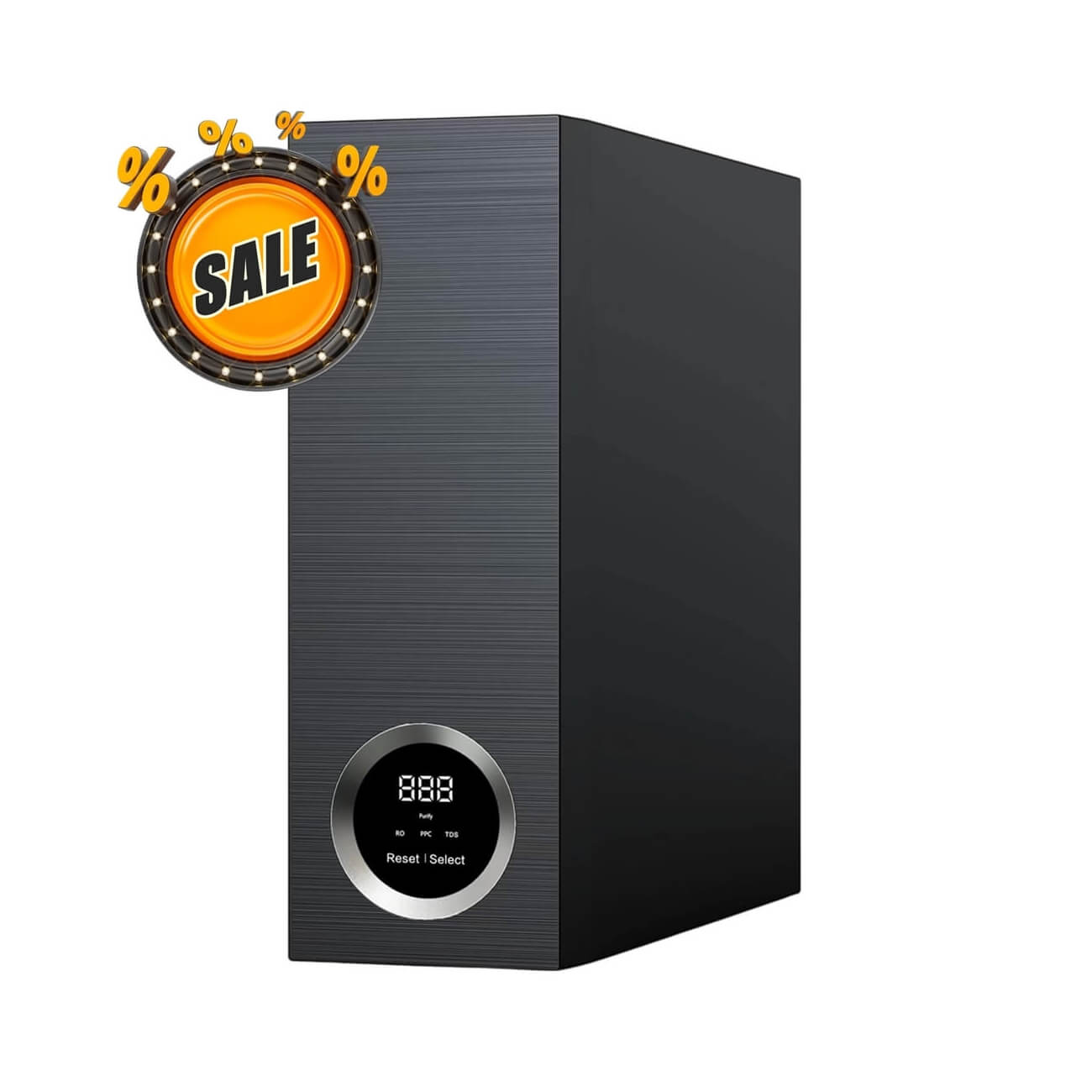
1000 GPD Compact TWO Flow reverse osmosis system
Professional solution: 1000 GPD Compact TWO
- Perfect for large families & frequent users & large aquariums
- Two-way faucet: for osmosis water and filter water
- Digital maintenance display
- Remineralization (optional) can be retrofitted
Tips for use and maintenance
Change filters in a timely manner : Included in every manual. Provided via email in PDF format after purchase.
Flush the system regularly : At least once a week. (e.g., with manual flushing functions, such as "Mobile" and "Small")
No downtime : If you do not use the system for several weeks, be sure to flush it weekly.
Store the system in a cool and hygienic place : Protect from sun and heat
Why you should buy from us – Advantages of Wasser-Shop24
✅ Large selection of tested brand products
✅ Value for money – top quality at fair prices
✅ Only new, original packaging – no remanufactured goods
✅ tested and certified products with drinking water approval (NSF, WQA)
✅ Long-term spare parts supply - also available in the future
✅ Advice & help via email and telephone
✅ Shipping from German warehouse – fast & secure
We're not just a shop—we're your partner for clean drinking water. Our product range includes reverse osmosis systems and matching filter media from Europe and Asia—tested, high-quality, and safe.
How to find your osmosis system
Here are a few selection criteria:
Number of people in the household
Daily water requirement
Budget and comfort requirements
Additional functions such as remineralization Tip: Use our product finder (menu) in the shop or contact our customer service – we will help you find the perfect system.
What you should know before buying
Note the following points:
Space required under the sink
Connection options (e.g. standard faucet or additional faucet)
Realistically estimate maintenance effort
Water consumption (wastewater ratio) A well-chosen model will save you money, time and stress in the long run.
Our customers' experiences with osmosis systems
Our customers report on:
Better skin appearance
More energy in everyday life
More pleasant taste of the water
Drink water without worry – even for children
No more limescale deposits in appliances
More than 17,000 satisfied customers trust us.
Practical experience
-
⭐⭐⭐⭐⭐
"Great support! A friendly team, helpful, and solution-oriented. They don't hesitate to expand their product portfolio if desired. Great support!"
- Martin R.
-
⭐⭐⭐⭐⭐
"I've been a Wasser-Shop24 customer for a while and, in addition to a technical problem, had many questions. They helped me kindly with a lot of patience and understanding. They also suggested ways to optimize my RO system. I'm very satisfied! Thank you very much!
- Tom K.
-
⭐⭐⭐⭐⭐
Simply fantastic! I've been a customer for years. Prices are always fair. The owner is competent and dedicated. Even with complicated questions, you get help promptly. Perfect, I'd say ;-)
- Sven B.
Conclusion: Osmosis systems are a real upgrade for your life
Reverse osmosis systems are the ideal solution for anyone who values their health, environmental awareness, and convenience. You get pure water straight from the tap – completely free of pollutants, without plastic, and without compromise. Whether for your family, everyday use, plants, or pets – a reverse osmosis system is worthwhile for every household.
We at Wasser-Shop24 are here to help you with experience, expertise, and the right products. Browse our shop now – discover our bestsellers, top offers, and practical filter sets. Because your body deserves only the best – pure water from an osmosis system .


